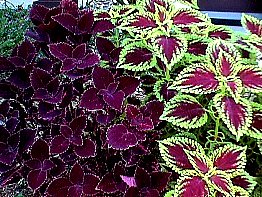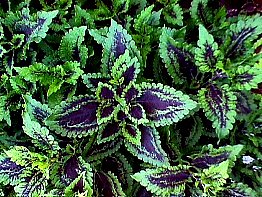|
Coleus blumei "Flame
Nettle" or "Poor Mans Croton" Family: LAMIACEAE
These plants are durable and easy
to Grow
 Coleus
are also quite striking when they are planted in a container, and grown
as a house plant. By removing the flower spikes as they develop, and keeping
the plant pinched back, the Coleus can be kept in a perennial state
for several seasons. Although these plants are a member of the nettle
family, they are a mint. They do not have the stinging properties of the
nettle.grow. They are best known for their bright colors, and variety of
foliage forms. Although they are technically a "tender perennial" (even
the slightest frost will cause them to die), they are most often considered
to be an annual plant by growers and seed producers. Coleus plants may
be grown in the garden in bright, indirect light, or in partial shade.
The lower growing dwarf varieties (6-12 inch) will create a colorful
border, or you can use the taller (three foot) types as a dramatic
background planting. Most Coleus plants will survive full sun exposure.
The foliage color however is often enhanced when they are grown in the
shade. Coleus
are also quite striking when they are planted in a container, and grown
as a house plant. By removing the flower spikes as they develop, and keeping
the plant pinched back, the Coleus can be kept in a perennial state
for several seasons. Although these plants are a member of the nettle
family, they are a mint. They do not have the stinging properties of the
nettle.grow. They are best known for their bright colors, and variety of
foliage forms. Although they are technically a "tender perennial" (even
the slightest frost will cause them to die), they are most often considered
to be an annual plant by growers and seed producers. Coleus plants may
be grown in the garden in bright, indirect light, or in partial shade.
The lower growing dwarf varieties (6-12 inch) will create a colorful
border, or you can use the taller (three foot) types as a dramatic
background planting. Most Coleus plants will survive full sun exposure.
The foliage color however is often enhanced when they are grown in the
shade.
DESCRIPTION:
These delicate plants have colored leaves or beautiful flowers. These plants
are natives of Indonesia and Africa. Coleus plants that have ornamental
leaves are descended from C. Blumei, which has nettle-like, bronze-colored
leaves. The colors of their foliage range through yellow, red, crimson,
and pink. The flowers that are produced on the varieties grown for their
colorful leaves are hardly noticeable. Others have plain green leaves but
bear gorgeous spikes of blue flowers in the winter. They are not good as
houseplants, but will survive in a greenhouse having a minimum night temperature
of 55-60 degrees with a 5-10 degrees rise in the daytime and a fairly humid
atmosphere. Coleus fredericii is an annual or biennial plant that has deep
purple flowers in late winter or early spring. It grows 3-4 feet tall.
C. amboinicus is a shrubby plant that grows about 2 feet tall. It has thick,
brittle, fuzzy green leaves that have a strong aroma. Their flowers are
lavender-pink.
COLEUS
AS A HOUSE PLANT.

A Coleus will make a nice house
plant as long as it receives sufficient light and food. Your Coleus should
be planted in a light, quick draining, commercial potting soil. Place it
where it will receive several hours of bright light (south window)
each day, or provide artificial "grow" lighting for best leaf color, and
fullest plant. Coleus plants will adapt to a wide range of temperatures
above 55 degrees, but will grow best when they are kept between 70 and
85 degrees. Keep the soil evenly moist, but never soggy. Feed your Coleus
plants monthly, with a diluted (50% mix) liquid house plant fertilizer.
Flower buds must be pinched off as soon as they develop to prevent the
plant from producing seeds. (The flower spikes are very insignificant.)
Once a Coleus is allowed to go to seed, it has completed it's life objective,
and it will usually die. Pinching may also be necessary to prevent leggy
growth. Any time that the tip growth is removed, the plant's energy will
be diverted to the lateral side growth, creating a much bushier plant.
Coleus are very durable, so you can cut your plant back severely if needed
(almost
back to the soil level).Coleus in the garden Coleus plants should not
be set into the landscape until the minimum outdoor temperature is 50 degrees
F. Although Coleus plants will usually survive in full sun, the foliage
color tends to intensify in light shade when they are grown outdoors. Plant
them twelve inches apart in rich, moist, well-drained soil with a neutral
or slightly alkaline pH. Feed monthly with a liquid all purpose fertilizer.
Pinch the center stems out when the plants are 4 to 6 inches tall to induce
bushier growth, and be sure to pick off the flower spikes as they form.If
the soil is allowed to dry out, the foliage will wilt, but normally will
recover quickly when additional water is provided. Water your plants thoroughly
at planting time, and then mulch the entire bed to conserve moisture. The
mulch will also help to heat up, and retain the heat in the soil, thereby
helping your plants to get established in their new home. Watch out for
mealy bugs, aphids and whitefly, as well as slugs and snails.
PROPAGATION:
Coleus
can be easily raised from seed. Seeds are sown in early spring in pots
containing light, sandy soil. They are covered lightly with soil and glass
is placed over it. Keep them in 65-75 degree temperatures. The seedlings
are then set 1 inch apart in flats of well-watered soil and shaded until
established. They are then potted separately. Cuttings of shoots, 2 inches
long, are inserted into sand, vermiculite, or other rooting mediums at
any time of year. They should be kept in a warm, moist propagating case
or be covered with a bell jar until they have formed roots. After they
have rooted, they are treated as seedlings. When they have almost filled
up their pots with roots, they should be transplanted into larger pots
that are filled with the same kind of soil mixture as described above in
the potting section, but with the addition of a little bone meal and dried
cow manure. The last repotting should be into pots ranging from 6-9 inches. |